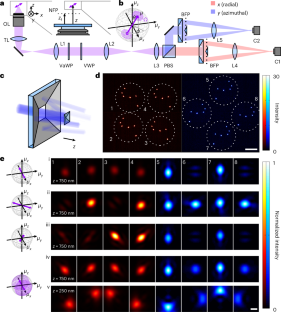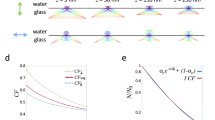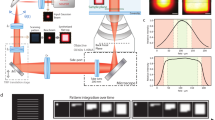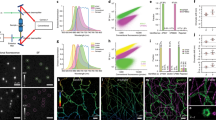Abstract
Imaging of both the positions and orientations of single fluorophores, termed single-molecule orientation-localization microscopy, is a powerful tool for the study of biochemical processes. However, the limited photon budget associated with single-molecule fluorescence makes high-dimensional imaging with isotropic, nanoscale spatial resolution a formidable challenge. Here we realize a radially and azimuthally polarized multi-view reflector (raMVR) microscope for the imaging of the three-dimensional (3D) positions and 3D orientations of single molecules, with precisions of 10.9 nm and 2.0° over a 1.5-μm depth range. The raMVR microscope achieves 6D super-resolution imaging of Nile red molecules transiently bound to lipid-coated spheres, accurately resolving their spherical morphology, despite refractive-index mismatch. By observing the rotational dynamics of Nile red, raMVR images also resolve the infiltration of lipid membranes by amyloid-beta oligomers without covalent labelling. Finally, we demonstrate 6D imaging of cell membranes, where the orientations of specific fluorophores reveal heterogeneity in membrane fluidity. With its nearly isotropic 3D spatial resolution and orientation measurement precision, we expect the raMVR microscope to enable 6D imaging of molecular dynamics within biological and chemical systems with exceptional detail.
This is a preview of subscription content, access via your institution
Access options
Access Nature and 54 other Nature Portfolio journals
Get Nature+, our best-value online-access subscription
$29.99 / 30 days
cancel any time
Subscribe to this journal
Receive 12 print issues and online access
$209.00 per year
only $17.42 per issue
Buy this article
- Purchase on Springer Link
- Instant access to full article PDF
Prices may be subject to local taxes which are calculated during checkout





Similar content being viewed by others
Data availability
The data underlying this study are openly available from OSF at https://osf.io/s8m4x/?view_only=f65ebe6038cc4bd79a8438be84e35309 and by request.
Code availability
The code used to analyse the data is available at https://osf.io/s8m4x/?view_only=f65ebe6038cc4bd79a8438be84e35309.
References
Norregaard, K., Metzler, R., Ritter, C. M., Berg-Sørensen, K. & Oddershede, L. B. Manipulation and motion of organelles and single molecules in living cells. Chem. Rev. 117, 4342–4375 (2017).
Stone, M. B., Shelby, S. A. & Veatch, S. L. Super-resolution microscopy: shedding light on the cellular plasma membrane. Chem. Rev. 117, 7457–7477 (2017).
Lyon, A. S., Peeples, W. B. & Rosen, M. K. A framework for understanding the functions of biomolecular condensates across scales. Nat. Rev. Mol. Cell Biol. 22, 215–235 (2021).
Emenecker, R. J., Holehouse, A. S. & Strader, L. C. Biological phase separation and biomolecular condensates in plants. Annu. Rev. Plant Biol. 72, 17–46 (2021).
Moerner, W. E. & Kador, L. Optical detection and spectroscopy of single molecules in a solid. Phys. Rev. Lett. 62, 2535–2538 (1989).
Moerner, W. E. Viewpoint: single molecules at 31: what’s next? Nano Lett. 20, 8427–8429 (2020).
Asenjo, A. B., Krohn, N. & Sosa, H. Configuration of the two kinesin motor domains during ATP hydrolysis. Nat. Struct. Mol. Biol. 10, 836–842 (2003).
Beausang, J. F., Shroder, D. Y., Nelson, P. C. & Goldman, Y. E. Tilting and wobble of myosin V by high-speed single-molecule polarized fluorescence microscopy. Biophys. J. 104, 1263–1273 (2013).
Backer, A. S., Lee, M. Y. & Moerner, W. E. Enhanced DNA imaging using super-resolution microscopy and simultaneous single-molecule orientation measurements. Optica 3, 659–666 (2016).
Backer, A. S. et al. Single-molecule polarization microscopy of DNA intercalators sheds light on the structure of S-DNA. Sci. Adv. 5, eaav1083 (2019).
Hulleman, C. N. et al. Simultaneous orientation and 3D localization microscopy with a vortex point spread function. Nat. Commun. 12, 5934 (2021).
Curcio, V., Alemán-Castañeda, L. A., Brown, T. G., Brasselet, S. & Alonso, M. A. Birefringent Fourier filtering for single molecule coordinate and height super-resolution imaging with dithering and orientation. Nat. Commun. 11, 5307 (2020).
Rimoli, C. V., Valades-Cruz, C. A., Curcio, V., Mavrakis, M. & Brasselet, S. 4polar-STORM polarized super-resolution imaging of actin filament organization in cells. Nat. Commun. 13, 301 (2022).
Ding, T., Wu, T., Mazidi, H., Zhang, O. & Lew, M. D. Single-molecule orientation localization microscopy for resolving structural heterogeneities between amyloid fibrils. Optica 7, 602–607 (2020).
Ding, T. & Lew, M. D. Single-molecule localization microscopy of 3D orientation and anisotropic wobble using a polarized vortex point spread function. J. Phys. Chem. B 125, 12718–12729 (2021).
Lu, J., Mazidi, H., Ding, T., Zhang, O. & Lew, M. D. Single molecule 3D orientation imaging reveals nanoscale compositional heterogeneity in lipid membranes. Angew. Chem. Int. Ed. 59, 17572–17579 (2020).
Zhang, O., Zhou, W., Lu, J., Wu, T. & Lew, M. D. Resolving the three-dimensional rotational and translational dynamics of single molecules using radially and azimuthally polarized fluorescence. Nano Lett. 22, 1024–1031 (2022).
Backlund, M. P., Lew, M. D., Backer, A. S., Sahl, S. J. & Moerner, W. E. The role of molecular dipole orientation in single-molecule fluorescence microscopy and implications for super-resolution imaging. ChemPhysChem 15, 587–599 (2014).
Zhang, O. & Lew, M. D. Quantum limits for precisely estimating the orientation and wobble of dipole emitters. Phys. Rev. Res. 2, 033114 (2020).
Zhang, O. & Lew, M. D. Single-molecule orientation localization microscopy II: a performance comparison. J. Opt. Soc. Am. A 38, 288–297 (2021).
Beckwith, J. S. & Yang, H. Information bounds in determining the 3D orientation of a single emitter or scatterer using point-detector-based division-of-amplitude polarimetry. J. Chem. Phys. 155, 144110 (2021).
Wu, T., Lu, J. & Lew, M. D. Dipole-spread-function engineering for simultaneously measuring the 3D orientations and 3D positions of fluorescent molecules. Optica 9, 505–511 (2022).
Mlodzianoski, M. J. et al. Active PSF shaping and adaptive optics enable volumetric localization microscopy through brain sections. Nat. Methods 15, 583–586 (2018).
Xu, F. et al. Three-dimensional nanoscopy of whole cells and tissues with in situ point spread function retrieval. Nat. Methods 17, 531–540 (2020).
Backer, A. S., Backlund, M. P., Lew, M. D. & Moerner, W. E. Single-molecule orientation measurements with a quadrated pupil. Opt. Lett. 38, 1521–1523 (2013).
Backer, A. S., Backlund, M. P., von Diezmann, A. R., Sahl, S. J. & Moerner, W. E. A bisected pupil for studying single-molecule orientational dynamics and its application to three-dimensional super-resolution microscopy. Appl. Phys. Lett. 104, 193701 (2014).
Zhang, O., Lu, J., Ding, T. & Lew, M. D. Imaging the three-dimensional orientation and rotational mobility of fluorescent emitters using the Tri-spot point spread function. Appl. Phys. Lett. 113, 031103 (2018).
Zhang, O. & Lew, M. D. Single-molecule orientation localization microscopy I: fundamental limits. J. Opt. Soc. Am. A 38, 277–287 (2021).
Novotny, L. & Hecht, B. Principles of Nano-Optics (Cambridge Univ. Press, 2012).
Backlund, M. P. et al. Removing orientation-induced localization biases in single-molecule microscopy using a broadband metasurface mask. Nat. Photon. 10, 459–462 (2016).
Thorsen, R. Ø., Hulleman, C. N., Rieger, B. & Stallinga, S. Photon efficient orientation estimation using polarization modulation in single-molecule localization microscopy. Biomed. Opt. Express 13, 2835–2858 (2022).
Böhmer, M. & Enderlein, J. Orientation imaging of single molecules by wide-field epifluorescence microscopy. J. Opt. Soc. Am. B 20, 554–559 (2003).
Lieb, M. A., Zavislan, J. M. & Novotny, L. Single-molecule orientations determined by direct emission pattern imaging. J. Opt. Soc. Am. B 21, 1210–1215 (2004).
Axelrod, D. Fluorescence excitation and imaging of single molecules near dielectric-coated and bare surfaces: a theoretical study. J. Microsc. 247, 147–160 (2012).
Lew, M. D. & Moerner, W. E. Azimuthal polarization filtering for accurate, precise and robust single-molecule localization microscopy. Nano Lett. 14, 6407–6413 (2014).
Moon, T. K. & Stirling, W. C. Mathematical Methods and Algorithms for Signal Processing (Prentice Hall, 2000).
Sharonov, A. & Hochstrasser, R. M. Wide-field subdiffraction imaging by accumulated binding of diffusing probes. Proc. Natl Acad. Sci. USA 103, 18911–18916 (2006).
Haass, C. & Selkoe, D. J. Soluble protein oligomers in neurodegeneration: lessons from the Alzheimer’s amyloid β-peptide. Nat. Rev. Mol. Cell Biol. 8, 101–112 (2007).
Iadanza, M. G., Jackson, M. P., Hewitt, E. W., Ranson, N. A. & Radford, S. E. A new era for understanding amyloid structures and disease. Nat. Rev. Mol. Cell Biol. 19, 755–773 (2018).
Butterfield, S. M. & Lashuel, H. A. Amyloidogenic protein-membrane interactions: mechanistic insight from model systems. Angew. Chem. Int. Ed. 49, 5628–5654 (2010).
Bode, D. C., Freeley, M., Nield, J., Palma, M. & Viles, J. H. Amyloid-β oligomers have a profound detergent-like effect on lipid membrane bilayers, imaged by atomic force and electron microscopy. J. Biol. Chem. 294, 7566–7572 (2019).
Hampel, H. et al. Core candidate neurochemical and imaging biomarkers of Alzheimer’s disease. Alzheimers Dement. 4, 38–48 (2008).
Choucair, A., Chakrapani, M., Chakravarthy, B., Katsaras, J. & Johnston, L. Preferential accumulation of Aβ(1-42) on gel phase domains of lipid bilayers: an AFM and fluorescence study. Biochim. Biophys. Acta 1768, 146–154 (2007).
Hane, F., Drolle, E., Gaikwad, R., Faught, E. & Leonenko, Z. Amyloid-β aggregation on model lipid membranes: an atomic force microscopy study. J. Alzheimers Dis. 26, 485–494 (2011).
Kuo, C. & Hochstrasser, R. M. Super-resolution microscopy of lipid bilayer phases. J. Am. Chem. Soc. 133, 4664–4667 (2011).
Moon, S. et al. Spectrally resolved, functional super-resolution microscopy reveals nanoscale compositional heterogeneity in live-cell membranes. J. Am. Chem. Soc. 139, 10944–10947 (2017).
Klymchenko, A. S. Solvatochromic and fluorogenic dyes as environment-sensitive probes: design and biological applications. Acc. Chem. Res. 50, 366–375 (2017).
Lee, S.-C. et al. Fluorescent molecular rotors for viscosity sensors. Chem. A Eur. J. 24, 13706–13718 (2018).
Danylchuk, D. I., Moon, S., Xu, K. & Klymchenko, A. S. Switchable solvatochromic probes for live cell super resolution imaging of plasma membrane organization. Angew. Chem. Int. Ed. 58, 14920–14924 (2019).
Harauz, G. & van Heel, M. Exact filters for general geometry three dimensional reconstruction. Optik 73, 146–156 (1986).
Banterle, N., Bui, K. H., Lemke, E. A. & Beck, M. Fourier ring correlation as a resolution criterion for super-resolution microscopy. J. Struct. Biol. 183, 363–367 (2013).
Dragsten, P. R. & Webb, W. W. Mechanism of the membrane potential sensitivity of the fluorescent membrane probe merocyanine 540. Biochemistry 17, 5228–5240 (1978).
Verkman, A. S. & Frosch, M. P. Temperature-jump studies of merocyanine 540 relaxation kinetics in lipid bilayer membranes. Biochemistry 24, 7117–7122 (1985).
Yu, H. & Hui, S.-W. Merocyanine 540 as a probe to monitor the molecular packing of phosphatidylcholine: a monolayer epifluorescence microscopy and spectroscopy study. Biochim. Biophys. Acta 1107, 245–254 (1992).
Wilson-Ashworth, H. A. et al. Differential detection of phospholipid fluidity, order and spacing by fluorescence spectroscopy of bis-pyrene, prodan, nystatin and merocyanine 540. Biophys. J. 91, 4091–4101 (2006).
Lagerberg, J. W., Kallen, K.-J., Haest, C. W., VanSteveninck, J. & Dubbelman, T. M. Factors affecting the amount and the mode of merocyanine 540 binding to the membrane of human erythrocytes. A comparison with the binding to leukemia cells. Biochim. Biophys. Acta 1235, 428–436 (1995).
Verkman, A. S. Mechanism and kinetics of merocyanine 540 binding to phospholipid membranes. Biochemistry 26, 4050–4056 (1987).
Sims, R. R. et al. Single molecule light field microscopy. Optica 7, 1065–1072 (2020).
Gustavsson, A.-K., Petrov, P. N. & Moerner, W. E. Light sheet approaches for improved precision in 3D localization-based super-resolution imaging in mammalian cells [Invited]. Opt. Express 26, 13122–13147 (2018).
Ponjavic, A., Ye, Y., Laue, E., Lee, S. F. & Klenerman, D. Sensitive light-sheet microscopy in multiwell plates using an AFM cantilever. Biomed. Opt. Express 9, 5863–5880 (2018).
Zelger, P. et al. Three-dimensional localization microscopy using deep learning. Opt. Express 26, 33166–33179 (2018).
Möckl, L., Roy, A. R. & Moerner, W. E. Deep learning in single-molecule microscopy: fundamentals, caveats and recent developments [Invited]. Biomed. Opt. Express 11, 1633–1661 (2020).
Nehme, E. et al. DeepSTORM3D: dense 3D localization microscopy and PSF design by deep learning. Nat. Methods 17, 734–740 (2020).
Nehme, E. et al. Learning optimal wavefront shaping for multi-channel imaging. IEEE Trans. Pattern Anal. Mach. Intell. 43, 2179–2192 (2021).
Wu, T., Lu, P., Rahman, M. A., Li, X. & Lew, M. D. Deep-SMOLM: deep learning resolves the 3D orientations and 2D positions of overlapping single molecules with optimal nanoscale resolution. Opt. Express 30, 36761–36773 (2022).
Speiser, A. et al. Deep learning enables fast and dense single-molecule localization with high accuracy. Nat. Methods 18, 1082–1090 (2021).
Bayerl, T. & Bloom, M. Physical properties of single phospholipid bilayers adsorbed to micro glass beads. A new vesicular model system studied by 2H-nuclear magnetic resonance. Biophys. J. 58, 357–362 (1990).
Acknowledgements
We thank A. Backer and V. Acosta for helpful discussions in designing the raMVR microscope. Aβ42 peptide was synthesized and purified by J. I. Elliott (ERI Amyloid Laboratory, Oxford, CT). Research reported in this publication was supported by the National Institute of Allergy and Infectious Diseases under grant no. R21AI163985 to M.D.V., by the National Science Foundation under grant no. ECCS-1653777 to M.D.L., and by the National Institute of General Medical Sciences of the National Institutes of Health under grant no. R35GM124858 to M.D.L.
Author information
Authors and Affiliations
Contributions
O.Z. and M.D.L. designed and built the raMVR imaging system. Z.G., Y.H. and M.D.V. prepared fixed HEK-293T cells. T.W. developed the protocol for preparing lipid-coated silica spheres. O.Z. performed experiments and analysed the data.
Corresponding author
Ethics declarations
Competing interests
A patent application covering the raMVR imaging technology reported in this manuscript has been filed by Washington University (O.Z. and M.D.L. as inventors, application no. PCT/US2021/063071). The remaining authors declare no competing interests.
Peer review
Peer review information
Nature Photonics thanks Sophie Brasselet, Bernd Rieger and the other, anonymous, reviewer(s) for their contribution to the peer review of this work.
Additional information
Publisher’s note Springer Nature remains neutral with regard to jurisdictional claims in published maps and institutional affiliations.
Extended data
Extended Data Fig. 1 Pyramid mirror designs.
(a) Alignment of the pyramidal mirrors and (b-e) dimensions of the (b) air pyramid, (c) one sector of the air pyramid, (d) mount for glass pyramid, and (e) glass pyramid. (i) Isometric view, (ii) top view, and (iii) side view of the mirrors and mount. Length unit: mm.
Extended Data Fig. 2 Simulation of rays propagating in the MVR system.
A total of 100 rays, randomly oriented within the imaging system’s numerical aperture and originating from random positions within the intermediate image plane (IIP) are shown. (a) Three-dimensional view of rays propagating within one of the polarized imaging channels. (b-d) Position of each ray at the (b) IIP, (c) glass pyramid, (d) air pyramid, and (e) detector. Scale bars: 50 mm in (a), 1 mm in (b,c), 5 mm in (d,e).
Extended Data Fig. 3 Light propagation within the second 4f system of the raMVR microscope.
(a) When folding mirrors FM1-4 are out of the emission path, detectors C1 and C2 observe the (i) radially and (ii) azimuthally polarized image plane. Colourbar: photons; scale bar: 2 μm. (b) When FM1 and FM3 are in the emission path and mirror M3 is properly aligned, detector C2 captures the (i) radially polarized BFP. Similarly, when FM2 and FM4 are in the emission path, detector C1 captures the (ii) azimuthally polarized BFP. Grid size: 1 cm; colourbar: normalized intensity; scale bar: 1 mm.
Extended Data Fig. 4 Image size comparison of CHIDO, the vortex DSF, raPol standard DSF and raMVR.
(a-d) Images and (e) line profiles of (a) CHIDO (x -polarized channel), (b) the Vortex DSF, (c) raPol standard DSF (radially polarized channel), and (d) raMVR (azimuthally polarized channel) for isotropic emitters located at z = 250 nm, z = 750 nm (best focus), and z = 1250 nm. The nominal focal plane zf = 1200 nm. Colourbar: normalized intensity; scale bar: 500 nm. (e) Line profiles of the DSFs in (a-d). Yellow: CHIDO; green: Vortex DSF; gray: raPol standard DSF; red: raMVR.
Extended Data Fig. 5 6D nanoscopic imaging of MC540 molecules bound to the membranes of another HEK-293T cell.
(a,b) Super-resolved images of two representative cells. Colours represent the estimated (a) axial position z and (b) azimuthal angle ϕ. Inset: summed diffraction-limited images from all imaging channels captured under lower excitation power. Scale bar: 2 μm. (c) yz - and (d,e) xy -views of boxed regions in (b). Lines are oriented and colour-coded according to the measured (c) polar angle θ, (d) wobble angle Ω, and (e) azimuthal angle ϕ. Their lengths are proportional to (c) \(\sqrt{{\mu }_{y}^{2}+{\mu }_{z}^{2}}\)) and (d,e) \(\sin \theta\). Scale arrows: 2 μm in (a,b), 500 nm in (c-e). (d) Insets show the distribution of measured wobble angle Ω within the yellow and white boxed areas (i,ii) and a side view of yellow and white boxed areas (i). Three-dimensional animations of the localizations in (c-e) are shown in Movie S5. (f) MC540 tilt Δϕ relative to the membrane surface within the white boxed areas in (d,e).
Extended Data Fig. 6 6D nanoscopic imaging of NR4A molecules bound to the membranes of HEK-293T cells.
(a-d) Super-resolved images of two representative cells. Colours represent the estimated (a,c) axial position z and (b,d) azimuthal angle ϕ. Insets: summed diffraction-limited images from all imaging channels captured under lower excitation power. Scale bar: 2 μm. (e,f,h) The zoomed regions of interest in (b,d). Lines are oriented and colour-coded according to the measured azimuthal angle ϕ. Their lengths are proportional to \(\sin \theta\). Scale bar: 500 nm. (g,j) Distributions of measured azimuthal angle from the membrane Δϕ within the white boxed areas in (e,f,h).
Supplementary information
Supplementary Information
Supplementary Sections 1–5, Figs. 1–32 and Tables 1–5.
Supplementary Video 1
Fluorescent beads on the surface of a glass coverslip (z = 0∘), embedded in lens immersion oil, axially scanned from zf = −500 nm to zf = 500 nm. Colour scale, photons; scale, 2 μm.
Supplementary Video 2
Three-dimensional view and cross-sectional images of Nile red localizations on the 1,000-nm-radius lipid-coated sphere in Fig. 3. Localizations are depicted as points at left and as line segments matching the measured molecule orientations at right. Colour scale, polar angle θ in degrees (left) and azimuthal angle ϕ in degrees (right).
Supplementary Video 3
Three-dimensional view of Nile red localizations on 350-nm-radius lipid-coated spheres incubated without (day 0) and with amyloid beta (Aβ42; Fig. 4). Colour scale, azimuthal angle ϕ in degrees.
Supplementary Video 4
Two-dimensional (xy) view of merocyanine 540 localizations along the HEK-293T cell membrane in Extended Data Fig. 5a, and a sliding window showing yz cross-sections. Localizations are depicted as points at left and as line segments matching the measured molecule orientations at right. Colour scale, axial position z in nm.
Supplementary Video 5
Three-dimensional view of merocyanine 540 localizations along the HEK-293T cell membrane in Fig. 5c–e and Extended Data Fig. 5c–e. Localizations are depicted as line segments matching the measured molecule orientations. Colour scale, polar angle ϕ in degrees (left), wobble solid angle Ω in sr (middle) and azimuthal angle ϕ in degrees (right).
Supplementary Video 6
Blinking merocyanine 540 molecules along the HEK-293T cell in Fig. 5a. Dashed lines represent where the cell is in contact with coverslip (bottom-right area in each channel). The nominal focal plane is placed at zf = 1,200 nm. Colour scale, photons; scale, 5 μm.
Rights and permissions
Springer Nature or its licensor (e.g. a society or other partner) holds exclusive rights to this article under a publishing agreement with the author(s) or other rightsholder(s); author self-archiving of the accepted manuscript version of this article is solely governed by the terms of such publishing agreement and applicable law.
About this article
Cite this article
Zhang, O., Guo, Z., He, Y. et al. Six-dimensional single-molecule imaging with isotropic resolution using a multi-view reflector microscope. Nat. Photon. 17, 179–186 (2023). https://doi.org/10.1038/s41566-022-01116-6
Received:
Accepted:
Published:
Issue Date:
DOI: https://doi.org/10.1038/s41566-022-01116-6



